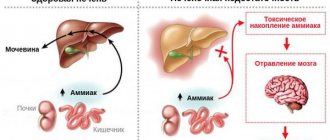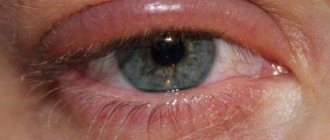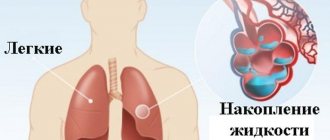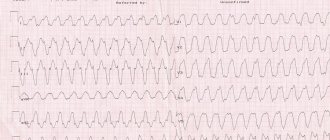5 / 5 ( 3 voices)
Anasarca is the most severe degree of edematous syndrome and is accompanied by fluid retention in the tissues and internal organs of the human body:
- lower limbs (from foot to thigh);
- external genitalia;
- torso;
- upper limbs (from shoulder to fingertips);
- neck and face;
- pleural cavity and lungs;
- abdomen;
- heart sac (pericardium).
Edema of the lower extremities
The concept of “anasarca” was specifically introduced into medical science in order to focus the attention of doctors on the critical condition of the sick person’s body, which requires emergency and resuscitation actions.
Normal tissue swelling does not pose a threat to the patient’s life, while anasarca is the accumulation of excess fluid in all body cavities and tissues, which leads to compression of internal organs and disruption of their basic function. A particular threat to the life of a sick person is edema of the pleural cavity and lungs, as it leads to insufficient gas exchange, increasing hypoxia and inhibition of the functioning of the brain and nervous system.
Abdominal edema in severe heart failure
Important! Anasarca is a consequence of decompensated pathologies and conditions of the body. The accumulation of fluid in organs and tissues is a protective reaction of the body, which is triggered to relieve the heart muscle and indicates a danger to human health and life.
General characteristics, classification of pathology
Under the influence of various factors, excess fluid can accumulate in the human body, which provokes edema. Often they affect only a certain part of the body, but sometimes the accumulation of liquid contents is observed in all tissues and cavities of the body. This applies to the torso, abdominal cavity, pericardium, lungs and pleural cavity, genitals, neck, face, upper and lower extremities.
Anasarca is a kind of protective mechanism. Total swelling serves as a signal, indicating excess stress. The development of such a pathological condition may be associated with several factors:
- increased hydrostatic pressure and load on the vascular wall;
- stagnation of blood in the vascular bed;
- fragility and excessive permeability of blood vessels;
- reduced oncotic and osmotic pressure of plasma;
- sodium retention in tissues, in which the ionic composition of the blood and intercellular fluid are redistributed.
Tissue swelling is usually not life-threatening, but in the case of anasarca, swelling affects all tissues and cavities. In this case, the internal organs are compressed, and their basic functions are disrupted, which is fraught with severe complications. The most dangerous are edema affecting the lungs and pleural cavity, as this provokes insufficiency of gas exchange, increasing hypoxia and subsequent inhibition of the functions of the brain and the nervous system closely related to it.
The etiology of anasarca can be different, therefore this pathological condition is classified into the following forms:
- traumatic - the skin is mechanically damaged, which causes swelling; this phenomenon often resolves on its own when the integrity of the vessels is restored;
- inflammatory – swelling is caused by an inflammatory process in the body, there is a high risk of severe complications;
- metabolic – edema occurs when metabolic processes are disrupted;
- homogeneous – blood flow is impaired;
- lymphogenous – the functioning of the lymphatic system is disrupted.
How does ascites develop?
The walls of the abdominal cavity are covered with a serous membrane (peritoneum). The membrane on the anterior inner surface of the abdomen is called the parietal peritoneum. The same serous membrane lines the free edge of the internal organs, softening their friction during movements (visceral peritoneum). The structure of the serous membrane is complex - it contains connective tissue fibers, blood and lymphatic vessels.
Fluid enters the abdominal cavity from the blood vessels that supply the serosa. In essence, this is plasma that has entered the cavity through the vascular walls. It spreads naturally and fulfills its physiological role. The plasma is constantly absorbed back into the bloodstream through the lymphatic vessels.
Ascites occurs when there is an increase in the amount of fluid that leaks into the abdominal cavity or when the lymphatic vessels do not absorb excess fluid. In case of serious metabolic disorders, electrolytes and protein compounds enter the abdominal cavity along with plasma. This increases the oncotic pressure and provokes even more active sweating of the plasma to restore the equilibrium of concentrations between blood and fluid in the abdomen.
The accumulation of fluid in the abdominal cavity serves as an excellent environment for the development of microorganisms, and also interferes with the normal functioning of internal organs.
Causes
Diseases of various organs and systems of the body can provoke anasarca. There are several main reasons for this pathological condition:
- Decompensated heart pathologies, which are accompanied by severe congestive heart failure. This applies to cardiomyopathies, myocarditis, and heart attack.
- Damage to the kidneys and urinary system, when there is renal failure or the outflow of urine and urodynamics are impaired. This applies to nephrotic and nephritic syndromes, which may accompany pyelonephritis, glomerulonephritis, urolithiasis, and renal amyloidosis.
- Hyperaldosteronism. This pathological condition involves increased production of aldosterone, a mineralocorticoid hormone. Its excess provokes electrolyte imbalance, including sodium retention and its concentration in the intercellular space.
- Diseases of the endocrine system accompanied by persistent hormonal deficiency (hypothyroidism). The main cause of anasarca is myxedema, in which the level of protein in the plasma sharply decreases.
- Allergy. In this case, severe angioedema is considered as anasarca. The main danger of this condition is swelling of the larynx, which without timely assistance can cause death.
- Excessive accumulation of toxins. This condition may be the result of chronic alcohol abuse or prolonged use of certain medications.
Determining the cause of anasarca is necessary for its effective elimination and prevention of relapses. In some cases, it is impossible to identify the factor that provoked such a pathological condition.
Diagnosis[edit]
Anasarca
is a diagnosis that is made clinically and differentiated from edema by the degree of damage to the body and severity. While edema is usually graded on a scale of mild/moderate/severe and usually affects one or two areas of the body, anasarca affects the entire body and is the most severe form of edema, with swelling of the subcutaneous tissue from the head to the toes.
Testing[edit]
Although there is no definitive test to confirm anasarca, many tests can be useful to aid in diagnosis. Anasarca is most often observed in combination with low albumin levels.
Recent studies have demonstrated an association between low-voltage electrocardiogram (ECG) (LVE) (QRS complexes <5 mm in the limb and <10 mm in the precordial leads) and anasarca. [8]
Symptoms of anasarca
The development of the clinical picture during anasarca can occur at different speeds. In most cases, symptoms increase gradually.
The following main characteristics of this pathological condition are identified:
- Total swelling. All areas of the body are affected. In most cases, it begins to swell in the lower extremities, although if the kidneys are damaged, the face and upper extremities may first suffer. The swelling then spreads to the genitals and torso. If you press on the skin, a mark will remain - the deeper it is, the more pronounced the swelling.
- Dyspnea. This symptom is one of the main ones during anasarca and indicates respiratory failure. The reason lies in the accumulation of transudate in the pleural cavity - this condition is called hydrothorax. A person lacks air during exercise, but as the pathology progresses, it can also bother him at rest. Severe compression of both lungs is fraught with severe and prolonged shortness of breath and acute respiratory failure.
- Cardiomegaly. This syndrome involves an increase in the size of the heart. With anasarca, this change occurs abruptly and usually indicates a cardiac origin of the edema. The heart enlarges due to hydropericardium (fluid accumulates in the cavity of the heart sac), and this, in turn, is caused by myocardial hypertrophy.
All these pathological changes during anasarca lead to the development of the following symptoms:
- weight gain;
- general malaise, weakness;
- decreased performance, limited physical activity;
- varicose veins, the appearance of spider veins;
- urination disorder.
Anasarca is dangerous not only for its clinical manifestations and their consequences, but also for its slow progression. In this case, the pathological condition is detected late, and therefore its treatment is not started in a timely manner, which negatively affects the prognosis of the underlying disease.
What to do?
If you think you have Anasarca
and the symptoms characteristic of this disease, then doctors can help you: therapist, endocrinologist, nephrologist.
We wish everyone good health!
Diseases with similar symptoms
ARVI (matching symptoms: 7 out of 20)
What is ARVI? Acute respiratory viral infections are contagious diseases of viral etiology that affect the body through the respiratory tract by airborne droplets. Most often, this disease is diagnosed in children aged 3–14 years. As statistics show, ARVI does not develop in infants; only isolated cases have been reported in which a child at that age suffered from the disease.
Did you like the article? Share with friends on social networks:
Diagnostics
It is quite easy to identify anasarca itself during a general examination, but diagnosing such a pathological condition also involves searching for the cause that caused it. Obtaining the necessary information requires an integrated approach, including laboratory and instrumental studies:
- blood and urine tests;
- allergy tests, test for tumor markers (differential diagnosis);
- electrocardiogram;
- ultrasound scanning (echocardiography, examination of the abdominal organs, pelvis, lungs);
- X-ray (examines the chest);
- computer, magnetic resonance imaging.
Various specialists can be involved in the diagnosis of anasarca. Depending on the characteristics of a particular case, they resort to the help of a cardiologist, endocrinologist, nephrologist, pulmonologist, hematologist.
Treatment of anasarca
Features of treatment depend on the causes of anasarca. A patient in this condition must be admitted to a hospital.
Drug therapy usually includes the following drugs:
- Diuretics. They ensure the removal of excess fluid from the body. Preference is given to loop diuretics: Furosemide, Triphas, Lasix. They are administered intravenously.
- Cardioprotectors. Such drugs are necessary when anasarca is caused by heart pathologies. They resort to cardiac glycosides (Digoxin, Korglykon), metabolic agents (Metamax, Mildronate).
- Corticoids (Dexamethasone, Methylprednisolone) and antihistamines (Suprastin, Tavegil). Such treatment is necessary if anasarca is caused by an acute allergic reaction.
- L-thyroxine. This drug is used as hormone replacement therapy.
If anasarca is caused by kidney damage, hemodialysis may be required. Plasma pressure can be increased by intravenous drip administration of its drugs and albumin.
Anasarca involves total swelling and can be a manifestation of various diseases. This condition is dangerous due to its slow progression and the risk of severe complications, so its timely detection, determination of etiology and appropriate treatment are important.
Links[edit]
- Kumar Vinay. Pathological basis of Robbins and Cotran's disease
. 8th ed. p.112; Philadelphia: Saunders Elsevier, 2010. ISBN 978-0-8089-2402-9 - Kattula, Sri Rama Surya Tez; Avula, Akshay; Baradi, Krishna M. (2020), "Anasarca", StatPearls
, Treasure Island (FL): StatPearls Publishing, PMID 30085555, retrieved 02 July 2021 - "Anasarca: causes, swelling and treatment". Health line
. 2017-07-11. Retrieved July 2, 2021. - "Anasarca: causes, treatment and definition". medicalnewstoday.com
. 2018-02-13. Retrieved July 2, 2021. - "Nephrotic syndrome - Symptoms and causes". Mayo Clinic
. Retrieved July 2, 2021. - Yasuda, Jessica Lacy; Rufo, Paul A. (02/26/2018). "Protein-losing enteropathy in the setting of severe anemia due to iron deficiency". Journal of Investigations in Medicine.
Significant Case Reports .
6
. DOI: 10.1177/2324709618760078. ISSN 2324-7096. PMC 5833205. PMID 29511696. - Mehta, Ankita; Shah, Mansi (2016). "Case Report: Uncontrolled Anasarca: Capillary Leak Syndrome". Medical forum
.
Medical Forum: Vol. 17, Article 8. 17
. DOI: 10.29046/TMF.017.1.009. Retrieved July 7, 2020. - Madias, J. E.; Bazaz, R; Agarwal, H; Win, M; Medepally, L. (September 2001). "Anasarca-mediated attenuation of electrocardiogram complex amplitude: a description of a hitherto unrecognized phenomenon." Journal of the American College of Cardiology
.
38
(3):756–64. DOI: 10.1016/s0735-1097(01)01429-2. PMID 11527629.










